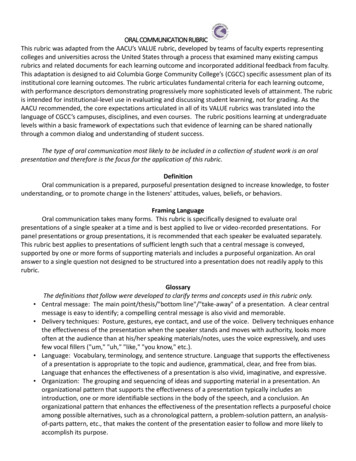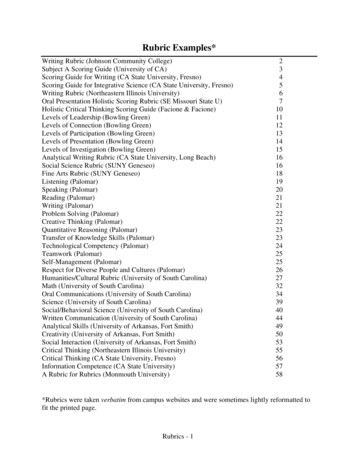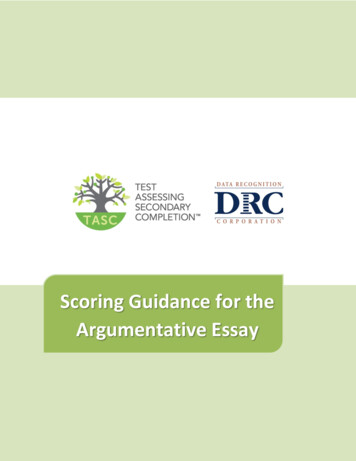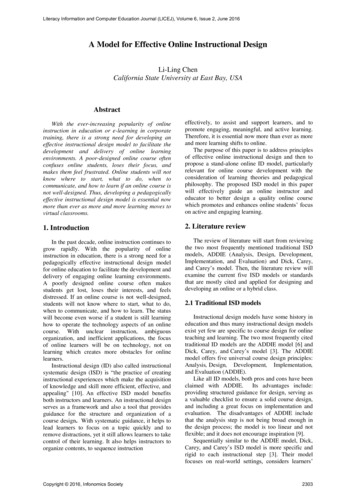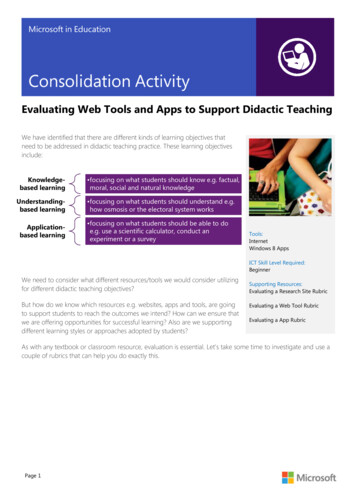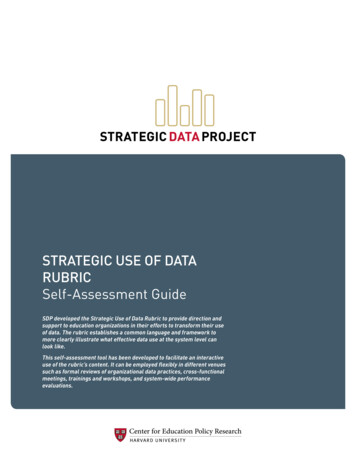
Transcription
STRATEGIC USE OF DATARUBRICSelf-Assessment GuideSDP developed the Strategic Use of Data Rubric to provide direction andsupport to education organizations in their efforts to transform their useof data. The rubric establishes a common language and framework tomore clearly illustrate what effective data use at the system level canlook like.This self-assessment tool has been developed to facilitate an interactiveuse of the rubric’s content. It can be employed flexibly in different venuessuch as formal reviews of organizational data practices, cross-functionalmeetings, trainings and workshops, and system-wide performanceevaluations.
Center for Education Policy Research at Harvard University Strategic Data Project 2014 President and Fellows of Harvard College.The Strategic Use of Data Rubric is made available under a Creative Commons Attribution-NonCommercial 4.0 International 4.0/.2 STRATEGIC USE OF DATA RUBRIC SELF ASSESSMENT TOOLcepr.harvard.edu/sdp
Center for Education Policy Research at Harvard University Strategic Data ProjectPROGRAMS AND MAJOR INITIATIVESOrganizational StrategyTo whatextentdoes theorganizationuse astrategic planto organizeprogramand initiativepriorities?QUESTIONS TO CONSIDER Does the organization have a strategic plan? Does it providedirection for major initiatives and programs? Is there a strategy for each program and initiative that is directlyconnected to overall strategy? How well does the organization understand all of its programs andinitiatives? Is the number of programs and initiatives manageable?BASICEXEMPLARYNo strategic plan; or if strategic plan exists, fails to informmajor initiatives.Strategic plan informs all major initiatives.Major initiatives/programs frequently generated, crisis-drivenand uncoordinated with strategy.Major initiatives aligned tightly with strategy; alignmentunderstood well by agency.Limited understanding of current initiatives. No complete list ofinitiatives in one place.Deep understanding of current efforts. New projects notauthorized without assessing current initiatives.No effort to avoid duplication across programs. No effort toeliminate or rationalize old initiatives.Limited number of major initiatives.No duplication across programs.Goal-SettingTo whatextentdoes theorganizationuse data andanalysis toset goals forprogramsand majorinitiatives?QUESTIONS TO CONSIDER Does the strategic plan (if it exists) have clear goals and targetsthat define successful outcomes? Are the goals achievable, but alsochallenging? Does each program, initiative, and work process have its own setof measurable goals and targets? Do they cascade down from thestrategic plan? To what extent are the targets used to guide programimplementation and outcomes? Are data and analysis used to establish and review goals and targets?BASICEXEMPLARYMajor initiatives are introduced without outcome orimplementation goals.Major initiatives introduced with goals, targets, timelines,responsibilities, and dependencies; all aligned with thestrategic plan.Targets and goals non-existent.Targets and goals exist, are both challenging and realisticand have been established from trend data, research, andpredictive analytics.Targets and goals are not well connected to implementation,operational outputs, or outcomes.Targets and goals are always directly connected toimplementation, operations, outputs, and outcomes.No monitoring of progress.Monitoring of progress includes review of implementation,measurement of outcomes, and use of predictive analytics toanticipate progress and adjust tactics.3 STRATEGIC USE OF DATA RUBRIC SELF ASSESSMENT TOOL: Section 1cepr.harvard.edu/sdp
Center for Education Policy Research at Harvard University Strategic Data ProjectPROGRAMS AND MAJOR INITIATIVESAccess and Use of Program DataTo whatextent aredata availableand utilizedto manageprogramsand informdecisionmaking?QUESTIONS TO CONSIDER Are program data stored in a central database? Are most relevantprogram data available and accessible? Does this data accuratelycapture all of the relevant aspects of program/initiative operations? Are data collected about the program before it begins operations? Are student-level data considered for decision making about scaling,continuing, or determining relative importance of the program? Arestudent-level data rigorously analyzed to understand the value of theprogram and drive decision-making about program operations?BASICEXEMPLARYProgram data (e.g., school, classroom, student-levelinformation) not housed centrally; some data not housed at all.Majority of program data is reliable and housed centrally.No baseline (pre-program) data available.Baseline (pre-program) data consistently collected beforeprogram start.Little analysis of student data to determine program adoptiondecisions and program priorities.Rigorous, comparative analyses and predictive analytics driveprogram adoption decisions and program priorities.Program Management and Monitoring with DataTo whatextent aredata used tounderstand,manage,and monitorcurrentprogramoperations?QUESTIONS TO CONSIDER Are programs and initiatives actively monitored? Are there formaltools used to manage progress on goals and timelines? Does the program consider information from national-levelresearch to influence its design and operations? Does the program consider results from programs previouslyimplemented at the organization? Are these results derived fromrigorous evaluation methods? Are similar programs considered alongside each other, comparingtheir relative value for students?BASICEXEMPLARYNo monitoring of program operations.Formal monitoring of programs against goals, targets, andtimelines. Examination of different scenarios that may alterprogram to increase impact, lower cost, or respond to change.Unaware of relevant research.Relevant research used to drive further internal research thatinforms and evaluates after pertinent information collected.No attention on results from prior programs.High attention on results that use data from prior programsand were evaluated with rigor and explicit pre-establishedcriteria.Similar programs not compared in terms of value to studentoutcomes.Similar programs compared in terms of impact and costeffectiveness.4 STRATEGIC USE OF DATA RUBRIC SELF ASSESSMENT TOOL: Section 1cepr.harvard.edu/sdp
Center for Education Policy Research at Harvard University Strategic Data ProjectPROGRAMS AND MAJOR INITIATIVESEvaluation and Decision MakingTo whatextentdoes theorganizationevaluate theoutcomes ofits programsand majorinitiatives?QUESTIONS TO CONSIDER Are programs/initiatives regularly evaluated? Are evaluation plans established before or after programs begin?Do evaluations use rigorous research methods? Are the results of evaluations used to adapt programs or influencedecisions about expansion or termination? Are decisions primarily driven by external factors and personalbeliefs or are they driven by the results of outcome evaluations?BASICEXEMPLARYNo evaluation plans exist.Evaluation plans exist for all major initiatives, and are explicit(with strong designs, including randomization) to determineinitiatives’ impact and next steps.Outcome evaluation not considered in decisions to continue,expand, or terminate programs.Outcome evaluations always influence closure or expansiondecisions, including standard use of sunset clauses to allowprogram expansion to be periodically evaluated.Decisions based on prior beliefs and assumptions rather thanevaluation results.Decisions always based on and driven by evaluation results.Closure decisions made erratically due to politics, shiftingpriorities, or immediate resource needs (i.e., budget crises).Closure decisions always based on results of evaluations;results generally immune to external influence.5 STRATEGIC USE OF DATA RUBRIC SELF ASSESSMENT TOOL: Section 1cepr.harvard.edu/sdp
Center for Education Policy Research at Harvard University Strategic Data ProjectPERFORMANCE MANAGEMENTTarget and Goal SettingTo whatextentdoes theorganizationuse data andanalysis toset goals forsystem-levelperformancemanagement?QUESTIONS TO CONSIDER Does the organization have a clear set of goals used to set targetsfor successful performance? Are goals measurable and establishedthrough data analysis? Does each area of the organization (schools, districts, departments,central, and overall) have a consistent set of goals? Do these goalsconnect and cascade from the top to the unit level? To what extent do organizational stakeholders participate in thetarget-setting process? Is the target-setting process clear, consistent and meaningful to allorganizational stakeholders?BASICEXEMPLARYFew, if any, targets exist for schools/districts, departments,or organization as a whole. Targets that exist not establishedthrough data analysis.A limited number of argets exist and are S.M.A.R.T. (Specific,Measurable, Attainable, Relevant, Time-Bound) targets setacross schools/districts, departments, or organization.Targets not consistent and even contradictory across levels(i.e., all schools or districts required to raise achievement by 2points per year while agency target is 5 points per year).Targets consistent throughout levels of organization andfunction in cascading manner. A “balanced scorecard” isused to set targets (i.e., targets incorporate a diverse set ofmeasures that may include student achievement, finance,operations, and human capital data).Organizational stakeholders do not participate in target-settingprocess. Targets not presented to staff or leadership in agency.Organizational stakeholders participate in target-setting processwith robust fact base. Meeting targets considered critical by staffand leadership.Target-setting process arbitrary, and unclear or unknown tomost organizational stakeholders (executive, departmental,district, or school-level leaders).Target-setting process clear and consistent across theorganization.Quality and Access to Organizational DataTo whatextent are theorganization’sdata andsystems ableto manageoperationsand trackperformance?QUESTIONS TO CONSIDER Where does relevant data live? Is some data stored separately fromother data? Is there a logical reason or does this create inefficiencies? Is necessary data available? To all relevant end-users? In real-time?At deep levels of granularity? Are relevant data accurate and reliable? When data are used for analysis or reporting, do end users obtainthe same results?BASICEXEMPLARYData not housed centrally; some data not housed at all; oftenreside mostly on paper or “rogue” spreadsheets.Data is reliable and majority is collected, stored, and reportedvia central database.Appropriate data generally not available.Appropriate data always available in real time, at multiplelevels, and with ability to “cut” data multiple ways usingappropriate tools to manipulate data.Data is generally inaccessible or accessible only through acomplex process.Data is consistently accessible to most internal users and torelevant external users.Available data often inaccurate and inconsistent data fromdifferent sources provides different answers for same question.Available data are predominantly accurate and providemultiple users consistent answers for same question.6 STRATEGIC USE OF DATA RUBRIC SELF ASSESSMENT TOOL: Section 2cepr.harvard.edu/sdp
Center for Education Policy Research at Harvard University Strategic Data ProjectPERFORMANCE MANAGEMENTPerformance Data for Measurement and MonitoringTo what extentdoes theorganizationuse outcomesto measureand monitororganizationalperformance?QUESTIONS TO CONSIDER Does the organization have a set of expected outcomes used forperformance management?Are these expectations clearly understood? Is performance reviewed consistently and regularly? To what extent are data used to measure performance? Is the datarelevant and specific enough to accurately represent outcomes?To what extent are performance targets generated throughrigorous analysis? Is progress regularly monitored? Can leaders determine how andwhy they are on/off track? Are there systems for rewards and consequences for meeting ormissing outcome targets? To what extent does accountability factorinto management decisions?BASICEXEMPLARYNo clear set of expectations or measurable outcomes used forthe performance evaluations that occur.Evaluations of performance based on clearly definedexpectations and measurable outcomes from studentachievement, human capital, budget, and operational data.No performance management targets exist to monitor school,district, and/or department progress towards goal(s).Performance management targets exist and are based onrigorous analysis.No formal review process.Reviews of school, district, and/or departmental progresstowards goal(s) conducted regularly and consistently.If performance is monitored, the process is unclear.Target monitoring clear; includes root cause analysis andaction planning informed by sophisticated data analysis.Little to no accountability systems in place.Accountability systems form the basis of all managementdecisions, and have active participation by seniorleadership. Review of progress includes action planning forinterdepartmental and department/school/district dependencies.7 STRATEGIC USE OF DATA RUBRIC SELF ASSESSMENT TOOL: Section 2cepr.harvard.edu/sdp
Center for Education Policy Research at Harvard University Strategic Data ProjectPERFORMANCE MANAGEMENTAccountability and Decision MakingTo whatextent isperformancemanagementused to informdecisionmakingand holdorganizationalmembersaccountablefor results?QUESTIONS TO CONSIDER Are external stakeholders informed about the performancemanagement process? To what extent are they involved in ensuringthat performance information is relevant for decision-making? Is performance management information available to the publicin a way that is meaningful for all relevant stakeholders (public,community, parents, board members)? Is performance used to drive decision and policy making byorganizational leaders?BASICEXEMPLARYExternal stakeholders (public, community, parents, boardmembers) have little understanding of what performancemanagement processes exist.External stakeholders provide support with collecting,reporting, and ensuring relevance of performancemanagement information and are well-informed aboutinformation’s relevance.No performance outcome information made public.All appropriate performance outcome information is publicand digestible.Performance management information is not used to informpolicy decisions.Performance management information is used for decisionmaking across all levels of the organization and continuouslyengages senior leadership.8 STRATEGIC USE OF DATA RUBRIC SELF ASSESSMENT TOOL: Section 2cepr.harvard.edu/sdp
Center for Education Policy Research at Harvard University Strategic Data ProjectRESOURCE ALLOCATION AND BUDGETINGFinancial Planning and StrategyTo whatextentdoes theorganizationemploy astrategicapproach tobudget andfinancialplanning?QUESTIONS TO CONSIDER Are budgeting or financial planning processes independent of orinformed by an overall organizational strategy? Does the organization have a multi-year or an annual budgetingprocess? To what extent does the organization perform long-term financialplanning? Does this planning consider different financial scenariosfor the organization?BASICEXEMPLARYFinancial planning not connected to strategy.Financial planning process has clear, public priorities alignedto agency’s education strategy.Yearly budget planning process based mostly on externaltimelines and previous year expenditures.Budget planning process multi-year, driven by strategy.Little to no long-term financial planning or resourcealignment.Long-term financial planning considers multiple revenuescenarios with clear action plans (i.e., what’s added or cut)for each scenario. Resource allocation based on educationalstrategy.Processes for Budgeting and Spending ReviewTo whatextent are theorganization’sbudget andresourceallocationsdriven by aclear andstructuredprocess?QUESTIONS TO CONSIDER Are program costs considered before programs are funded? Is therea formal process to prioritize the relative value of initiatives anddetermine funding levels? Does spending get reviewed consistently and regularly? To whatextent are rigorous analysis used to review spending? To what extent do organizational stakeholders participate in thebudgeting process? To what extent are the budgeting process implications understoodacross the organization?BASICEXEMPLARYProgram and policies enacted without consideration of costsor resource availability.Formal budgeting process ranks initiatives in terms ofrelative importance.There is no regular review process for spending.Spending is periodically reviewed using departmentalbudgets with sophisticated financial analyses (e.g., zerobased budgeting or activity-based costing techniques).Budget process involves only a few central office leaders.Budget includes open communication of information betweencentral offices and schools/departments.Budget process understood only by a few central officeleaders.Budget process understood by central office and all schools/departments.9 STRATEGIC USE OF DATA RUBRIC SELF ASSESSMENT TOOL: Section 3cepr.harvard.edu/sdp
Center for Education Policy Research at Harvard University Strategic Data ProjectRESOURCE ALLOCATION AND BUDGETINGUse and Analysis of Financial DataTo whatextentdoes theorganizationuse data andanalysis toreview andadjust budgetallocations?QUESTIONS TO CONSIDER Are budget requests and changes aligned to overall organizationalstrategy? Are budget requests submitted with a robust set of evidence? Is the return on the investment considered to evaluate fundingrequests and budget changes? Is the budget stable across time? To what extent can it beresponsive to changes in financial conditions?BASICEXEMPLARYLine item additions and subtractions made ad hoc without factbase or reference to agency strategy.Line item additions aligned to strategy and consideredtogether, not individually.Budget requests made without evidence-based justification.Budget requests required and made with robust, evidencebased justifications.No attempts made to generate impact estimates for budgetcuts or additions.Relative “return on investment” of requests considered andused to prioritize funding.Budget allocations inconsistent and inflexible. Small resourcechanges cause crises in the system.Overall funcing strategy consistent and stable, but alsoflexible enough to rapidly respond to resource changes.Accountability and Decision-MakingTo whatextentdoes theorganizationconsiderdata-drivenoutcomesto informdecisionmaking?QUESTIONS TO CONSIDER Are departments responsible for managing their expenditures?To what extent does accountability for outcomes factor intothe level of expenditures? Are program or department outcomes reviewed alongsideexpenditures? To what extent are these results used to drivebudgeting decisions made by organizational leaders? To what extent are rigorous analysis and formal processes used todecide budget and resource allocation? Are there a clear set of criteria used to evaluate budget requests?Are these made available to relevant stakeholders (public, community,parents, board members)?BASICEXEMPLARYDepartments not held accountable for expenditures oroutcomes.Departments and or schools held accountable for bothexpenditures and outcomes; clear connections are madebetween the two.Financial reviews and reviews of departmental outcomes arenot linked.Financial reviews are always linked to departmentaloutcomes and directly impact budgeting decisions made byboth department heads and senior leadership.Budget allocations determined through political pressure orpersonal relationships.Budget allocations and required resources determinedthrough fact-based analysis to allocate resources forprograms and departments. Required resources explicitlybudgeted and appropriately resourced via formal process.No public criteria to evaluate budget requests.Clear public criteria to evaluate budget requests.10 STRATEGIC USE OF DATA RUBRIC SELF ASSESSMENT TOOL: Section 3cepr.harvard.edu/sdp
Center for Education Policy Research at Harvard University Strategic Data ProjectASSESSMENT WORKSHEETTo complete the self-assessment, consider the guiding questions associated with each category, and use the endsof the rating scale, “Basic” and “Exemplary” as guideposts to situate your organization. Then, select one of the fourrating columns that best represents your organization’s data use in this area.PERFORMANCE MANAGEMENTPROGRAMS AND MAJOR INITIATIVESBASICOrganizationalStrategyTo what extent does theorganization use a strategicplan to organize program andinitiative priorities?Goal-SettingTo what extent does theorganization use dataand analysis to set goalsfor programs and majorinitiatives?Access and Useof ProgramDataTo what extent are dataavailable and utilized tomanage programs and informdecision-making?ProgramManagementand Monitoringwith DataTo what extent are data usedto understand, manage, andmonitor current programoperations?Evaluationand DecisionMakingTo what extent does theorganization evaluate theoutcomes of its programs andmajor initiatives?Target andGoal SettingTo what extent does theorganization use data andanalysis to set goals forsystem-level performancemanagement?Quality andAccess toOrganizationalDataTo what extent are theorganization’s data andsystems able to manageoperations and trackperformance?PerformanceData forMeasurementand MonitoringTo what extent does theorganization use outcomesto measure and monitororganizational performance?Accountabilityand DecisionMakingTo what extent is performancemanagement used to informdecision-making and holdorganizational membersaccountable for results?1 STRATEGIC USE OF DATA RUBRIC SELF ASSESSMENT TOOL: dp
Center for Education Policy Research at Harvard University Strategic Data ProjectASSESSMENT WORKSHEETRESOURCE ALLOCATION AND BUDGETINGBASICFinancialPlanning andStrategyTo what extent does theorganization employ astrategic approach to budgetand financial planning?Processesfor Budgetingand SpendingReviewTo what extent are theorganization’s budget andresource allocations drivenby a clear and structuredprocess?Use andAnalysis ofFinancial DataTo what extent does theorganization use data andanalysis to review and adjustbudget allocations?Accountabilityand DecisionMakingTo what extent does theorganization consider datadriven outcomes to informdecision-making?2 STRATEGIC USE OF DATA RUBRIC SELF ASSESSMENT TOOL: dp
2 STRATEGIC USE OF DATA RUBRIC SELF ASSESSMENT TOOL cepr.harvard.edu/sdp Center for Education Policy Research at Harvard University Strategic Data Project 2014 President and Fellows of Harvard College. The Strategic Use of Data Rubric is made available under a Creative Commons Attribution-NonCommercial 4.0 International License:

